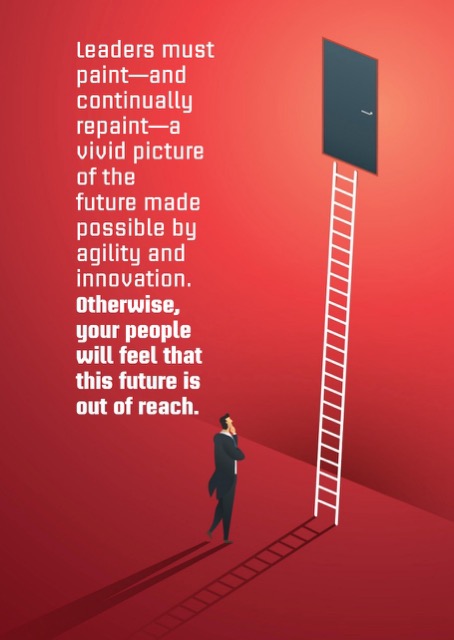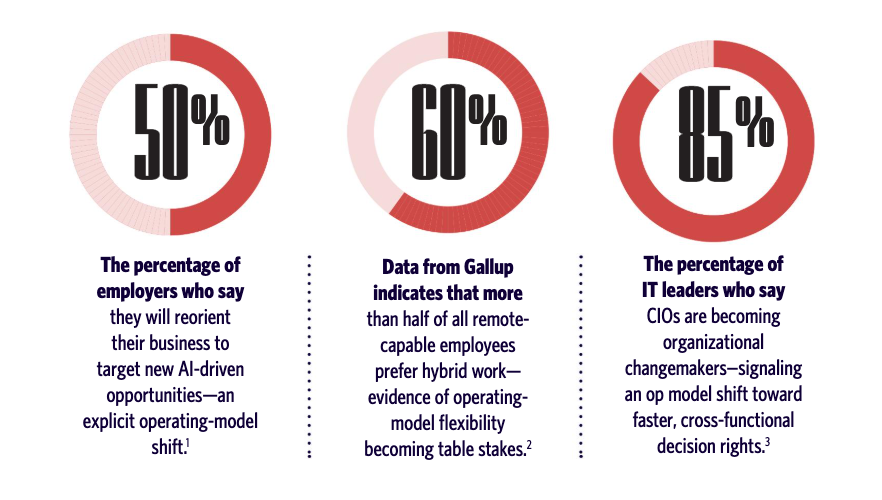- Breakthrough Imperatives
- Featured
- Insigniam Perspectives
- IQ Insigniam Quarterly® Magazine
- Winning at the Speed of Change
Is Your Operating Model Killing Growth?
The faster the world moves, the stronger the instinct to tighten our grip. At Insigniam, we see its effects across industries and verticals. Markets whipsaw, technology compresses planning horizons, supply chains knot without warning, and the operating model that once felt dependable begins to feel like a constraint. The common reaction is to add control: more approvals, thicker playbooks, tighter gates. The impulse is understandable and the effect is predictable. However, the lesson of the past few years is not that enterprises must engineer more certainty; it is that operating models must perform without it. Resilience is not a response to disruption. Resilience is the operating model.
This is why legacy designs optimized for control and efficiency are buckling under new expectations. Customers care far more about how we make them feel than how we are organized internally. Employees are unwilling to expend their best effort in systems that stall learning and blunt initiative. Partners judge us by the speed and clarity of our commitments, not by the elegance of our org charts. When any one of these constituencies encounters friction, the cost shows up everywhere else—churn, rework, delays, missed opportunities.
Furthermore, data shows that the trend lines are clear. In the United States, employee engagement fell to 31% in 2024—a decade low—and global engagement declined 21%, with managers experiencing some of the sharpest drops. Those are not HR anecdotes; they are operating-model diagnostics. If people are disengaged, the model is failing them, and it will fail the strategy next.
 In our work, Insigniam advises clients to pay attention to signals—early, often uncomfortable indicators that the current way of operating no longer serves the enterprise. In consumer markets, unfamiliar entrants often start winning for reasons that are difficult to explain from within the incumbent’s frame. In the B2B space, teams often design around internal constraints
In our work, Insigniam advises clients to pay attention to signals—early, often uncomfortable indicators that the current way of operating no longer serves the enterprise. In consumer markets, unfamiliar entrants often start winning for reasons that are difficult to explain from within the incumbent’s frame. In the B2B space, teams often design around internal constraints
because they lack direct data from end customers and cannot clearly see real demand to inform their design. On the talent side, when missed hiring goals are casually explained away as “we should raise compensation,” it is often a sign that the employee experience is broken, not just the pay band. These moments precede performance decline and illustrate when a model is out of tune with reality.
Leaders who catch these signals early can act while they still have degrees of freedom.
Design for Adaptability, Not Certainty
The leadership trap we most often encounter is the belief that an operating model can deliver certainty. It cannot. At its best, an operating model provides three things: consistency—the shared principles and decision rights that keep a complex enterprise pulling in the same direction; adaptability—learning loops that turn weak signals into timely action; and structure—clear ways of working that create speed instead of friction. Demanding certainty produces the opposite. Processes harden, decisions centralize, and responsiveness decays. The external environment makes the point plain. This year’s Global Risks Report, published by the World Economic Forum, ranks armed conflict and extreme weather among the most urgent near-term risks, while misinformation and disinformation remain top short-term threats—an agenda that argues for rapid re-orientation, not rigid plans.
We describe future-ready operating models with three characteristics: experience-led, culture-powered, and dynamically governed. Experience-led means we design backward from the outcomes we intend for customers, employees, and partners—what people should consistently experience when they interact with us—and only then align value streams, capabilities, and technology to make those outcomes reliable. Culture-powered means the behaviors, norms, and leadership practices actually match the model we are installing. Too many transformations die in execution because the culture remains calibrated for a previous strategy. Dynamically governed means that decision rights and mechanisms evolve in response to the context.
We simplify, decentralize, and push authority to the edges, where information is freshest, while maintaining the center through a small set of explicit principles and a transparent framework for trade-offs.
These are not optional features. They are design constraints. Remove any one of them and performance will slip the moment conditions change.
At Insigniam, our Target Operating Model (TOM) exists to hardwire those characteristics. We begin by asking deceptively simple questions, and we refuse to advance until we can answer them in plain language. What do we want customers, employees, and partners to experience when they encounter us? Which value streams actually produce those experiences, end to end? What business and capability requirements must exist to deliver them every time? How will we organize, lead, and govern to keep that promise at scale? What is the sequence of work, the benefits, and costs that will bring the model to life? And finally, what does implementation look like when it is paced so that customers feel the change quickly and employees are equipped to thrive as it scales?
While the method may be straightforward, the discipline is not. The gravitational pull of the old model is strong, and the organization’s immune system is real. Hence why we must “act consistent with the future we want, now.” Leaders must paint—and continually repaint—a vivid picture of the future made possible by agility and innovation, so people want to go there, not because a program office insists, but because it is obviously better than the status quo. This denotes a structural shift from “efficiency only” to “experience and efficiency.”
Additionally, in a world where switching costs are low, outcomes beat outputs. Customers expect intuitive, personalized, low-friction interactions that respect their time. Employees expect modern tools, coaching-centric managers, and visible mobility. Partners expect clarity, speed, and credible commitments. When any one of those groups meets unavoidable friction, the whole system pays.
The macro context is both bracing and encouraging. According to the Conference Board’s Measure of CEO Confidence report, positive sentiments rebounded toward neutral territory, rising in the third quarter of 2025 after a trough earlier in the year. The data is a reminder that, even in choppy markets, leaders see opportunities to seize. At the same time, the skills agenda has become inescapable. The World Economic Forum predicts that 39% of workers’ core skills will change by 2030, and 85% of employers plan to prioritize upskilling as their top workforce strategy. An operating model that cannot close that gap while it runs will not keep up.
Tech Follows the Operating Model
One question we’re frequently asked—especially as emerging tech continues to rewrite the executive playbook—is what role technology should play in the op-model conversation.
Without question, technology belongs in that conversation, but only in its proper place. It is an amplifier of the operating model, not a substitute for it. When the model is unclear, automation accelerates confusion; when the model is crisp, it accelerates value creation.
Evidence from the Work Trend Index is instructive: Compared with skeptics, ardent users of AI report that they have re-oriented their workdays in fundamental ways and are saving more than 30 minutes per day, with gains concentrated in drafting, search, and summarization; savings that compound when paired with redesigned roles and decision rights. Those results do not happen by magic. They occur when we rewire our ways of working and equip people to utilize the tools to focus on the work that matters most. And although tech can be an accelerator, culture is where models live or die. No operating model survives a culture that contradicts it.
If we flatten governance to move decisions closer to customers but still reward risk-avoidance, people will wait for permission. If we invest in data and AI but underinvest in management capability, middle managers become bottlenecks—not by intent but by design. The economics underscore the point.
Gallup estimates that not-engaged and actively disengaged employees account for roughly $8.9 trillion in lost productivity—about 9% of global GDP—while manager engagement itself has declined in the most recent global data. On the P&L, replacement costs commonly reach a third of the base salary, and as much as 40% of overall turnover occurs in the first year, when investments in recruiting and onboarding have not yet yielded a return. The case for an experience-led, culture-powered model writes itself.
Govern for Speed, Measure What Matters
Organizations that move quickly know exactly who makes decisions, at what threshold, by when, and with what inputs. They establish review rhythms that turn data into decisions—weekly operating reviews along value streams, monthly forums that surface cross-enterprise experience patterns, and quarterly strategy refreshes anchored in signal analysis rather than habit. They replace encyclopedic rulebooks with a handful of non-negotiables—safety, trust, privacy, and financial stewardship—so teams can act locally while staying aligned globally. Recent headlines indicate that markets are rewarding this posture, and capital is flowing into the infrastructure necessary to run more automated and data-driven operating models.
Case in point, Microsoft guided record quarterly capital expenditures to the order of $30 billion, and Alphabet raised its 2025 plan to about $85 billion, signaling more to come. Investors do not fund those sums unless speed of learning and speed of decision are real sources of advantage.
In effect, these measurement keeps us honest. If we track only top and bottom-line outcomes, we miss the mechanics that produce them. In our work, we separate the external value loop and the internal capability loop and insist they speak to each other. The value loop covers growth, margin, and cash, and pairs those with indicators that reflect lived experience, such as loyalty and the share of spend we earn over time. The capability loop tracks the health of the model itself, including the cycle time from signal to decision, engagement levels by manager and team, adoption of new ways of working, first-year retention, quality at the source, and adherence to the model versus exception rates.
We advise choosing a small set of leading indicators, publishing them widely, and making it everyone’s job to improve them. If the signal-to-decision cycle stretches, the model is telling you where it hurts. If first-year retention improves while rework declines, culture is translating into performance.
Leaders often ask how to begin without creating a program that is so heavy it collapses under its own weight. We recommend starting by naming the future rather than the problem. Describe, in unambiguous terms, the experiences you intend to create for customers, employees, and partners. If those outcomes cannot be expressed clearly, the model cannot be designed to deliver them.
Next, we advise mapping value streams to the experiences that our clients intend to deliver, so the outcomes are tied to the work that actually produces them. We trace the flow end to end to see how value really moves—surfacing hand-offs, bottlenecks, and the shadow processes people rely on to get work done. That view makes the cost of legacy governance unmistakable: approvals layered in the name of control that add time but not judgment. With the reality on the table, we redesign decision rights and roles so decisions sit as close to the work as prudence allows, using clear thresholds for risk, spend, and brand that turn escalation into a fast lane rather than a maze. Finally, we build the enabling system—skills, data, technology, and incentives—around those choices so the new design holds in day-to-day operations.
As we redesign how value is created, we must also redesign how people build the skills to deliver it. The World Economic Forum’s latest analysis quantifies the scale of change: core skills will shift by nearly two-fifths this decade, and a decisive majority of employers plan to prioritize upskilling through 2030. This is why capability building must be integrated into the operating model, not merely alongside it. We embed learning into roles, workflows, incentives, and reviews so capability growth is part of running the business, not a side program competing for attention.
Once capabilities are defined, we install a learning cadence that converts signals into changes in how work is done. Weekly operating reviews surface patterns and test fixes; monthly forums examine customer and employee experience; quarterly strategy resets align investments to what the data now shows. Managers play a different role in this cadence. We equip them to coach rather than police, because behavior change is what turns tools into outcomes. Where organizations provide teams with modern tools and explicit permission to use them, we consistently see time freed from low-value tasks and redeployed to work that matters to customers; the Work Trend Index echoes these gains among power users when new habits stick.
A quick health check is straightforward: Are teams shrinking the time from signal to decision? Are managers spending their weeks on priorities, blockers, and improvement rather than status? And are first-year retention rates improving while rework falls? When the answers are yes, the model is learning.
Make Resilience Operational
Winning now requires a choice, not a slogan. Choose to run the business on an operating model built for motion. In practice, that means making a time-bound commitment: in the next quarter, name the outcomes you will create for customers, employees, and partners; pick one or two value streams where those outcomes matter most; and publish who decides what, at what threshold, and on what cadence. Put leadership attention where it converts fastest—weekly operating reviews that turn signals into changes in how work is done, managers who coach rather than police, and a small set of leading indicators everyone can see and move. Treat every source of friction as a defect, not a personality trait; remove it and keep moving forward.
As capability builds, sequence technology to amplify the new design rather than decorate the old one. Start where judgment is bounded and the work is repetitive; stage AI and automation into those flows once roles, data, and decision rights are clear. Reinvest the time you free into better experiences and faster learning loops. Measure progress in cycle time from signal to decision, in first-year retention, in fewer escalations and exceptions—because those are the mechanics of advantage. When you miss, adjust the model, not the aspiration.
This is the leadership mandate: make the future present, wire the enterprise to learn faster than conditions change, and insist on a culture people are proud to own. The organizations that act on this now will not merely cope with uncertainty; they will turn it into momentum. That is how we win at the speed of change.



